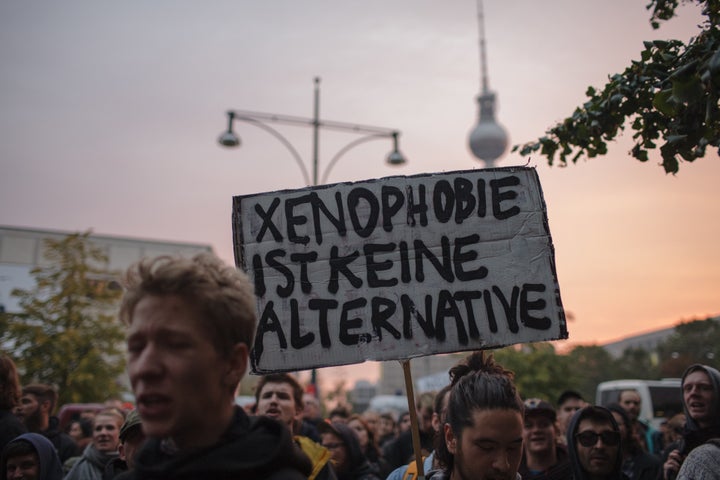Two days after Chancellor Angela Merkel won a fourth term in power, Germany is still contemplating the results of a national election that has left the country with a dramatically altered political landscape.
Merkel’s CDU is headed for difficult coalition talks, the once-powerful center-left suffered big losses and the far-right has made unsettling gains after having been isolated on the political fringe for decades.
But among the most striking elements revealed in Sunday’s vote is a stark divide between the country’s east and west. Strong support in the east for the anti-immigrant, anti-Islam Alternative for Germany party, or AfD, highlights the clear divisions in how different regions and social demographics see the challenges of the future.
The far-right rises in the east
The AfD managed to appeal to a spectrum of voters across social demographics, winning just under 13 percent of the vote on Sunday. But the party’s greatest gains came in what was formerly communist East Germany ― where in some regions over a third of voters backed the party.
The AfD averaged around 22 percent of the total vote in Germany’s east, more than double the 11 percent it scored in the west. Among men, a major support base for the party, the gap was even wider: Around 26 percent of eastern male voters gave their support to the far-right.
Much of the AfD’s campaign relied on anti-immigrant rhetoric and attacks on Merkel’s decision to allow over a million asylum-seekers into Germany at the peak of Europe’s refugee crisis in 2015. But the areas that seemingly had the largest influx of immigrants were not where the AfD did best.
Just like the United Kingdom’s Brexit referendum and France’s national election earlier this year, the AfD saw most support in areas where immigration is actually quite low.
“Often times it’s the most diverse areas that are least likely to vote for these parties, and you can see that in the United States. The coastal regions are far more diverse than many regions inside of our country, and yet they’re the most liberal,” Sheri Berman, a professor of politics at Barnard College, told HuffPost.
Political scientists have put forward a number of different theories for why this discrepancy exists, Berman says. One prominent explanation is that the number of immigrants in a region isn’t as important for pushing voters to the right as how fast demographics there change, and whether that region has a history of integrating new types of citizens.
“From that perspective, the fact that east Germany has a less diverse population, fewer immigrants, fewer refugees than much of the west does is less relevant than that things have changed more there,” Berman said.

The AfD capitalized on pre-existing divides
Although the rise of the AfD marked a rightward shift for Germany, voting divisions had existed since the country’s reunification in 1990. The east had long been a stronghold for The Left party, which opposed the status quo represented by Germany’s two largest parties ― the Christian Democratic Union and the Social Democrats.
But there had been signs long before Sunday’s vote that eastern Germany had been shifting further to the right. Merkel’s campaign stops in the east were often harangued by AfD protesters, who chanted and tried to shout down the chancellor’s speeches. In state elections last year, the AfD made big gains in regions to the east, like Saxony-Anhalt.
Anti-immigrant, anti-Islam movement PEGIDA, which embraces openly hateful rhetoric, also has its largest base of support in the east, especially around Dresden, where the group was formed in 2014. Despite attempts from some AfD officials to downplay any direct links with PEGIDA, the two share many ideological similarities, and hundreds of party members rallied together with the radical group in the week before the election.
The AfD ultimately picked up hundreds of thousands of supporters from The Left party, which lost over 6 percent of its vote share in eastern Germany compared to the last election.
A new party of protest
Analysts see the shift as indicative that the AfD has taken over as the party of protest for disaffected Germans, many of whom reside in eastern regions that have lagged behind the rest of country economically.
“The context of the east still remains somewhat different from the west. It’s still more economically depressed. There’s been more out-migration, so a lot of communities there have been somewhat hollowed,” Berman said.
Out of Germany’s 30 largest companies, for instance, none were based in the east of the country as of 2015.

Experts also explain the increased popularity of more radical parties in east Germany as a symptom of its history, which has produced different norms regarding nationalism and extremism than in western Germany.
“West Germany over the last few decades has made almost an industry of what Germans call ′Vergangenheitsbewältigung,′ which is sort of overcoming or dealing with the past,” Berman said.
In the east, however, analysts say there was a less pronounced culture of atonement for Nazism. As a result, they contend that German far-right parties have had an easier time finding support in the east, where there is a less entrenched aversion to radical political movements.
“The east was all about the memory of the time under communism, so they had a different emotional take on these extreme nationalist parties,” said Mabel Berezin, a professor of sociology at Cornell University.
But while the AfD saw far greater support in eastern states, its appeal is hardly contained there. The party’s more than 10 percent vote share in the west is an indication that its anti-immigrant, nationalist message also has supporters who are in more affluent parts of the country with stronger taboos against the far-right. The AfD’s success instead speaks to a wider shift in what the country finds publicly acceptable.
“What [the AfD] is saying is that it’s OK to think these things now and it’s OK to vote for these kinds of parties,” Berezin says.
“It really signifies a departure from the kinds of political and cultural and moral norms that had governed German political culture.”
